
There's somebody out there for everybody. You just have to wait for god to bring them into your life.
Wednesday, September 30, 2009
Puffed sky

Puffed sky
Sorry for not being here. I still can't sit for long periods of time without my back letting me know (via little shooting pains down my right leg) that I shouldn't.
Not much has happened. The night of a thousand sleep interruptions was followed by the morning of entirely too much caffeine. Complete with hand tremors! (I hummed TMBG's Lie Still Little Bottle all day long.)
I had finally gone to the doctor, and came home with three little orange bottles. (I was reminded that I am really and truly an adult when I can say things like, "Please give me a shot.") I'd thought muscle relaxers always enduced drowsiness, but the original brand of horse pills he prescribed put such a hair trigger on my sleep that I had to call and beg for something else. Near-total deprivation of REM sleep might not necessarily turn me into a serial killer, but I wasn't willing to experiment. The new ones are tiny, and leave me a bit loopy, so if none of this makes any sense, that's why.
Canada Geese have seemed restless, honking their way across the property several times a day, and even at night, which was new for me. Maybe I just slept through it all before.

Puffed sky at sunset with river of grackles (click to enlighten)
Tuesday, September 29, 2009
A (Pashley) Penny for Your Thoughts

The Pashley Pennyis the companion model to the Parabike I wrote about earlier. This unusual bicycle looks vaguely old-fashioned, but unlike the Parabike it is not based on a specific vintage design. Part cruiser, part mixte and part mountain bike, its uniqueness is enhanced by eccentricities such as the split curved downtubes. The Penny defies classification, and this seems to be how the manufacturer intends it - explaining that the bike "provides the perfect excuse to experience more rural rides."

While the Parabike's aesthetic is defined by the continuous curvature of its top set of twin stays, from head tube to rear dropouts, in the Penny the curve is interrupted and inverted. This difference is so visually dominant that it overshadows the structural similarities between the two bikes. The Penny also lacks the military/historical somberness of the Parabike, coming across as more light-hearted.
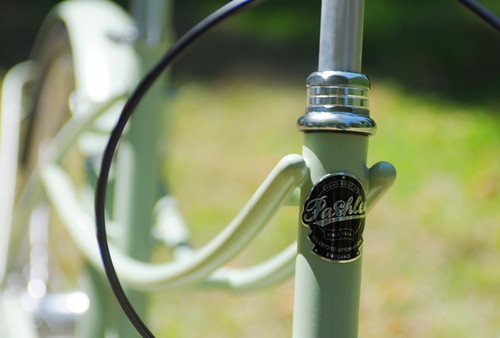
Made of cro-moly steel, the Penny is handbrazed and powdercoated in Stratford-upon-Avon in England, like all Pashley bicycles. It is fairly lightweight for its category of bikes, coming in at under 30lb.
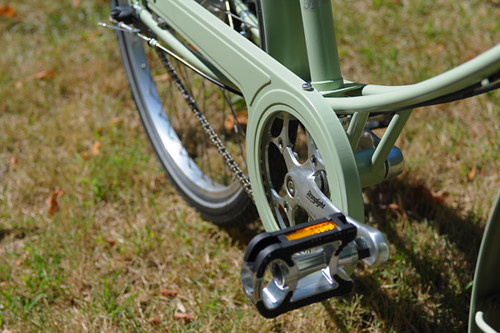
Like the Parabike, the Penny is built for 26" wheels and fitted with 26 x 1.75" Schwalbe Marathon tires.Colour-matched fenders and chainguard are included.

Components include a 5-speed Sturmey Archer hub, hand-operated hub brakes front and rear, a Brooks B67S saddle, a Stronglight crankset, non-slip platform pedals, rubbery "faux cork" grips, and a large bell.Unlike the Parabike, the Penny is set up with straight, rather than swept back, handlebars.
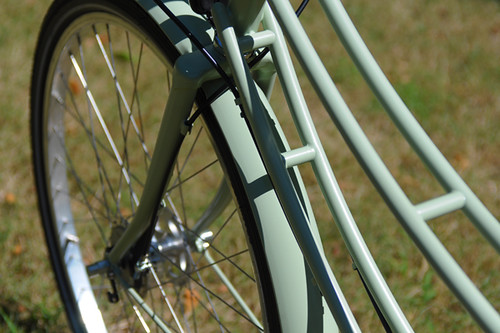
Standing over the bicycle for the first time, I was overwhelmed by all the flowy slender tubes; it was a bit like standing over a swaying rope bridge. Not that the tubes sway. It's the form and the repetition that give that impression of movement. A unique design to be sure.

One thing I had wondered about when seeing pictures of the Penny, was whether the stepover was low enough to be practical. Unlike a traditional mixte, the twin parallel stays here don't extend all the way down to the rear dropouts, but connect to the upper seat stays - which places them rather high. However, this is compensated for by their downward sweep. When mounting the bike, the stepover height resembles that of a typical mixte.
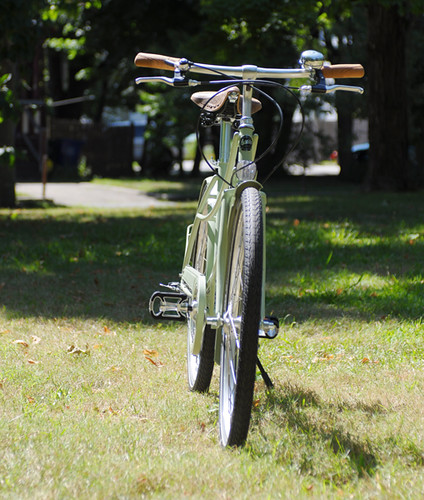
Riding the Penny, my first impression was that it felt too small for me (I am just under 5'7"). My test riding partner agreed that the Penny's "cockpit," even with the straight handlebars, felt smaller than the Parabike's. Later I looked up the sizes of the two bikes and was surprised to see them described as the same: 19" (48cm). Of course this measurement refers to the seat tube length, and it's possible that the Penny's virtual top tube is shorter than the Parabike's. Regrettably, I did not measure the bikes and have not been able to source geometry charts. But the good news is that the Penny will work well for smaller riders and those with shorter torsos.
Putting the fit issue aside, the ride quality and handling of the Penny felt very similar to that of the Parabike, which I liked very much: maneuverable, extremely cushy over bumps, mountain-bikey but with a relaxed cruiserish element to it.These are entirely different bikes from Pashley's Roadster and Princess line.Personally, I prefer the way the Penny and Parabike ride to the classic Princess. Of course the looks are a matter of taste.

One advantage of the Penny over the Parabike, is that - to my eye at least - its aesthetics do not conflict with a standard rear rack. So turning it into a practical city bike would be fairly simple. Unfortunately, dynamo lighting is not included. Also not included are the waterbottle cage mounts that I noticed on the Parabike. Step-through frame designs often do not lend themselves to this, and it's too bad. Finally, I am not sure why the Penny was set up with straight handlebars rather than swept-back bars - I suspect that much of this bike's target market would find the the latter more comfortable.
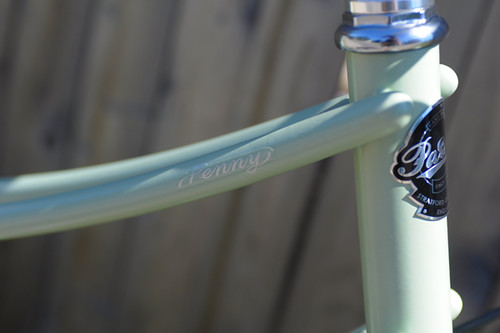
In their description of the Penny, Pashley suggests that this bike is meant to move effortlessly between town and country. I can see that. Provided that it's a fairly flat area, this bike could feel equally enjoyable to ride through meadows and forests, on cobblestones and on busy city streets, for shorter and longer distances. It is a nice combination of comfortable, maneuverable, and intuitive to handle. The durable powdercoat and the enclosed brakes and gears allow outdoor storage and make this bike a good choice for winter and inclement weather conditions. If the unique look of the Penny appeals to you, the bike is worth taking seriously.
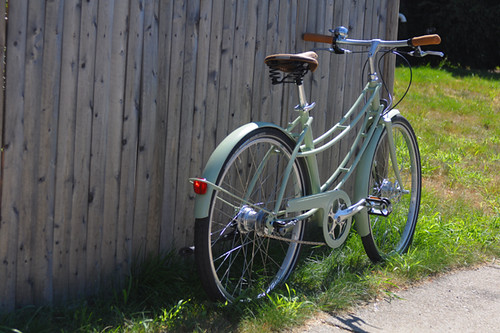
The Pashley Penny is available in "willow green" (shown here) or "dusk blue" - a dusty indigo. Current retail price is $1,195. Both the Parabike and Penny are available for test rides at Harris Cyclery in West Newton, MA. Many thanks to them for setting up these demo bikes.
Friday, September 25, 2009
Rediscovering Familiar Places... and the Hills You Never Knew Were There
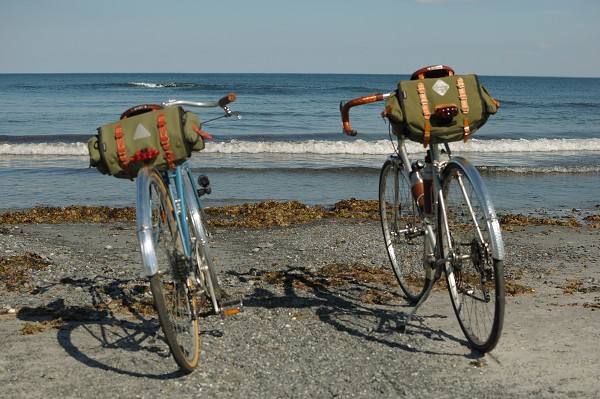 Yesterday was a special occasion for us, and we wanted to do something special to celebrate. We decided to visit an area of Seacoast New Hampshire and Southern Maine where we used to live a few years back - but for the first time, get around entirely on our bicycles.
Yesterday was a special occasion for us, and we wanted to do something special to celebrate. We decided to visit an area of Seacoast New Hampshire and Southern Maine where we used to live a few years back - but for the first time, get around entirely on our bicycles. We began by driving to Portsmouth, NH - which is only an hour North of Boston. We parked in a municipal lot, unfastened the bicycles, and set off. Portsmouth itself is a fantastic town and is very easy to cycle in, but our destination was Maine - which is accessible via a very cool truss lift bridge.
We began by driving to Portsmouth, NH - which is only an hour North of Boston. We parked in a municipal lot, unfastened the bicycles, and set off. Portsmouth itself is a fantastic town and is very easy to cycle in, but our destination was Maine - which is accessible via a very cool truss lift bridge.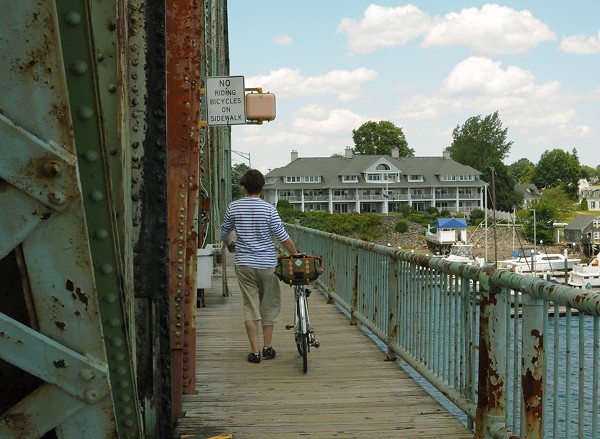 We had to wait for some ships to pass underneath, but they soon lowered the bridge and we walked our bicycles across.
We had to wait for some ships to pass underneath, but they soon lowered the bridge and we walked our bicycles across.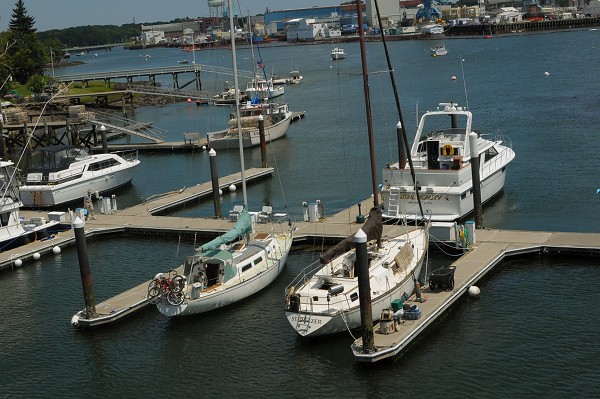 The views from this bridge are amazing, and we even spotted a boat with some bicycles strapped to it.
The views from this bridge are amazing, and we even spotted a boat with some bicycles strapped to it. The Co-Habitant's Myles.
The Co-Habitant's Myles.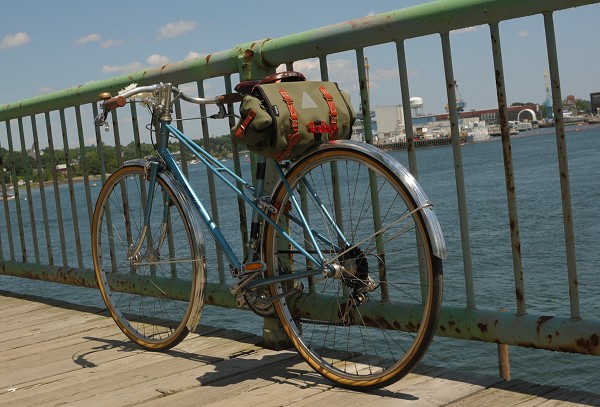 And my Marianne, enjoying the view. I took the vintage mixte, because I wanted to be more upright than on my roadbike - so as to have a better view of the scenery and to carry a camera across my back. All of that I did, but at the expense of both comfort and speed: Despite her beauty, this bicycle is just not as pleasant to ride as the Rivendell Sam Hillborne, and without drop bars it is also not as fast. In fact, now that I am finally building up my custom new mixte, we have plans for Marianne that will rescue her from redundancy - but I will save that for later.
And my Marianne, enjoying the view. I took the vintage mixte, because I wanted to be more upright than on my roadbike - so as to have a better view of the scenery and to carry a camera across my back. All of that I did, but at the expense of both comfort and speed: Despite her beauty, this bicycle is just not as pleasant to ride as the Rivendell Sam Hillborne, and without drop bars it is also not as fast. In fact, now that I am finally building up my custom new mixte, we have plans for Marianne that will rescue her from redundancy - but I will save that for later.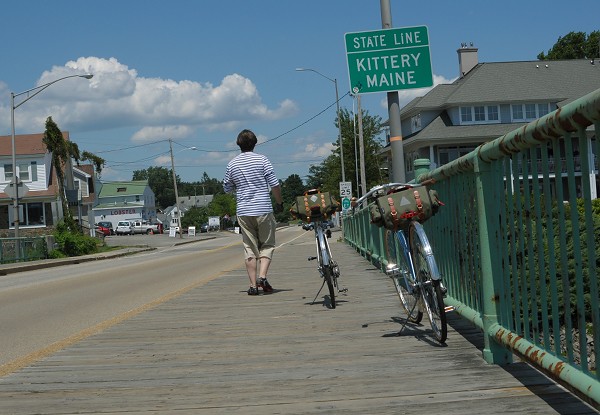 And here we are, in Kittery Maine. This was the first time we crossed a state line on bicycle.
And here we are, in Kittery Maine. This was the first time we crossed a state line on bicycle.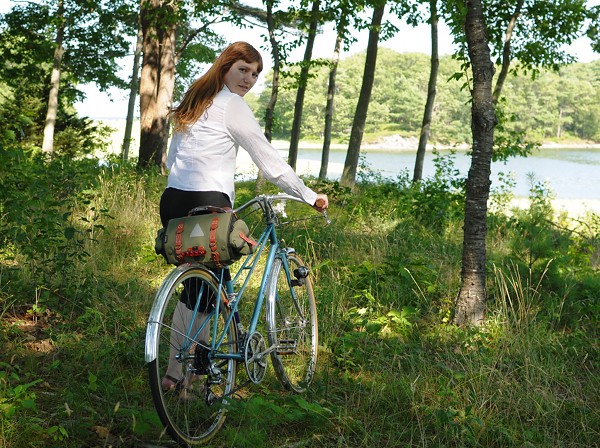 I like to think that I know coastal Southern Maine like the back of my hand. And if you were to ask me, "Is it hilly?", a few days ago I would have answered "not at all" - and I would have been so wrong! It is amazing how we are just not as aware of topography in a car as we are on a bicycle.
I like to think that I know coastal Southern Maine like the back of my hand. And if you were to ask me, "Is it hilly?", a few days ago I would have answered "not at all" - and I would have been so wrong! It is amazing how we are just not as aware of topography in a car as we are on a bicycle.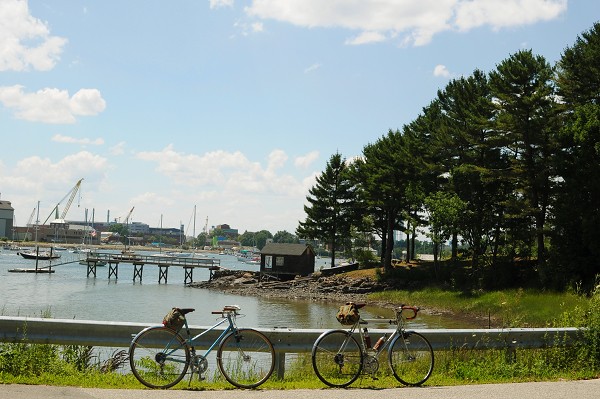 We have a favourite road in this area that is an off-shoot of Route 1A and offers spectacular views of the coastline, and I simply do not remember this road having hills. But on my 12-speed Motobecane mixte, I was soon switching gears all over the place as I tried to keep up with the frequent and considerable changes in elevation.
We have a favourite road in this area that is an off-shoot of Route 1A and offers spectacular views of the coastline, and I simply do not remember this road having hills. But on my 12-speed Motobecane mixte, I was soon switching gears all over the place as I tried to keep up with the frequent and considerable changes in elevation. Still, it was so worth it and our trip was spectacular; I would most definitely recommend Southern Maine for touring. The traffic on the roads was much lighter than we expected, and cycling was considerably more peaceful than in the countryside around Boston. There are many non-touristy spots in the Kittery, York, and Ogunquit areas where the beaches are pristine, the restaurants are inexpensive, and the landscape is not cluttered with "motel sprawl".
Still, it was so worth it and our trip was spectacular; I would most definitely recommend Southern Maine for touring. The traffic on the roads was much lighter than we expected, and cycling was considerably more peaceful than in the countryside around Boston. There are many non-touristy spots in the Kittery, York, and Ogunquit areas where the beaches are pristine, the restaurants are inexpensive, and the landscape is not cluttered with "motel sprawl". Steamers, caught on the property of the restaurant that serves them. When it comes to seafood in Maine, there is so much choice that you really need to know where to go, so it helps having once been a local. Our favourite place was right along our route, and we happily stopped by after all those lovely hills.
Steamers, caught on the property of the restaurant that serves them. When it comes to seafood in Maine, there is so much choice that you really need to know where to go, so it helps having once been a local. Our favourite place was right along our route, and we happily stopped by after all those lovely hills. All in all, this was probably the nicest cycling trip we have taken so far. Next time we will figure out how to plan it so that we can keep going further North before turning back - maybe stay in a motel somewhere overnight. One of our favourite places on Earth has become even "favouriter", once traveled by bicycle.
All in all, this was probably the nicest cycling trip we have taken so far. Next time we will figure out how to plan it so that we can keep going further North before turning back - maybe stay in a motel somewhere overnight. One of our favourite places on Earth has become even "favouriter", once traveled by bicycle.
The Round House
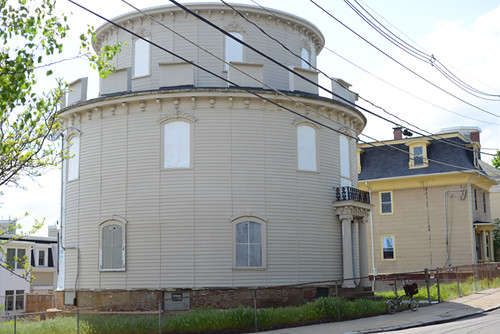
It is no small task to describe the entity that is "Camberville" - that serpentine Somerville-Cambridge city line with its mazes of pocket neighbourhoods, unkempt grapevines, mysterious alleys lined with crumpling garages, and grandiose structures tucked away on sleepy side streets. Wandering through a neighbourhood you think you know, it is not unusual to encounter something wholly unexpected - perhaps a sidewalk treehouse, an enchanted forest, a small castle, or a warehouse-sized artisan incubator.

Very possibly I have cycled past the Round House before without taking much notice. The once-grand structure is not difficult to miss, now only a shadow of its former self. A lusciously overgrown garden torn out some years ago, a grass lot and chainlink fence now surround its bare walls, stripped of trim and embellishment. A thicket of condominiums stands in what was once an open space, blocking the house from view in certain directions.
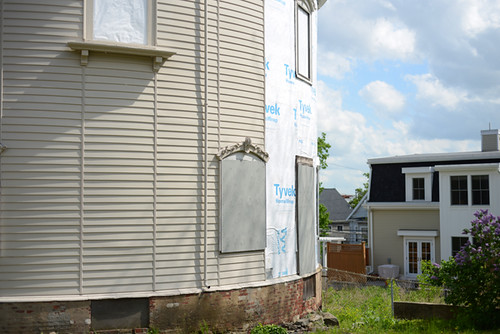
But on this ghostly-quiet afternoon, I noticed it straight away. It was one of those humid days when the air stands still and the scent of flowers is sickly sweet. The weekend's explosion of lilacs was making me lightheaded. I cycled up a steep hill, and as I turned the corner onto a tiny one-way street the house appeared like a hallucination -backlit by the waning sun and tilting slightly to the left.

Stopping to have a look, I was distracted by the prominent signs discouraging trespassing. They struck me as so insincere as to almost be playful.

I was intrigued further by the curious discrepancy between the siding - which appeared newly installed - and the foundation, which seemed on the verge of collapse.

And then there was the bulging wall.
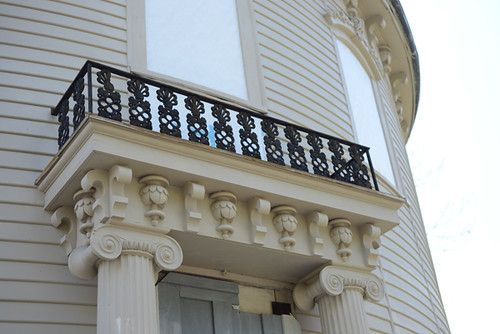
Strange to think that a Victorian-era locksmith is responsible for this cylindrical wonder. Inspired by the idea of octagonal houses floating around at the time, Somerville resident Enoch Robinson decided to take things one step further and build a round house. Constructed in 1856, the 3-story single family residence housed generations of Robinson's family.

It is not clear why the Round House was vacated and stood empty for so long. But by the 1980s it had its windowsand ornamentation removed, had suffered water damage and faced serious structural problems. There was talk of tearing it down, which, predictably, riled up residents who saw it as a landmark of historical value. Thankfully, it never came to that. Several years ago, the house was purchased by a developer with experience in historical preservation. He plans to restore the house and place it on the market as a single family home.

The Round House was created on a whim, to satisfy a personal interest - possibly an obsession, judging by the limited information I found on its creator. Yet by virtue of existing in a publicly visible and visitable space, it is also a communal resource, and will continue to be as ownership changes hands. How will the new residents feel about that, I wondered, eying the awkward battlements that surround the top story. I hope they plant a nice garden. Maybe some lilacs, dogwood and pines, against that stark beige facade.
Clipless Pedals on a Fixed Gear
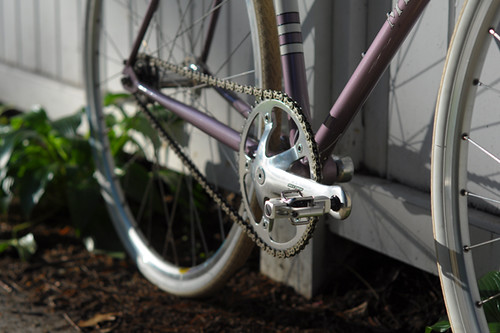
For the final phase of my transition to clipless pedals, I've now installed them on my fixed gear roadbike. I knew that clipless would be trickier on fixed gear than on a freewheel bike, since you have to clip in and out while continuing to turn the pedals.I expected to have two specific problems: getting my left foot clipped in once I got going (I start with the right), and unclipping. For obvious reasons, the latter one worried me especially: What if I could not unclipwith the pedals revolving constantly?
Now that I've done it, my impressions of the whole process are different from what I'd imagined. Clipping in my left foot is not as tricky as I thought. Yes, the pedal keeps going. But at least I no longer have to fish aroundfor a strapwith my toe as it rotates. Instead I just hang on and keep pressing into it even if the cleat doesn't engage right away; eventually it does. And clipping out is fine. Some cyclists say that they can only unclip when the pedal is in a specific position, but I guess I have been spared that problem. Sure, some positions are more awkward than others, but I can still unclip from them.
So that's the good news. The bad news, is that starting is surprisingly challenging. I guess I didn't think this part through very well ahead of time. On a freewheel bike I clip in my starting foot on the downstroke, then pull the pedal up to start. Within a fairly short amount of time, this process has already become automated. Of course on a fixed gear you can't pull the pedal up without lifting the rear wheel, which I've never managed to learn how to do. So when I try to start I nearly topple over, because I automatically try to pull up on the pedal and all this does is jerk the bike violently. It's kind of funny that I do this every time, even though I knowthat you can't pull up on the pedal in fixed gear. Habits form quickly!
Anyhow. So I am not quite there yet with clipless in fixed gear, but I am enjoying the challenge. I either need tolearn how to quickly lift the rear wheel while pulling up on the pedal, or reprogram my brain to clip in my starting foot on the upstroke, the way I used to do with Power Grips. Suggestions from fixed gear cyclists most welcome. Is there a way to make this easier on myself?
Wednesday, September 23, 2009
Cape Blanco
Monday, September 27, .. - - Cape Blanco State Park, eight miles northwest of Port Orford, Oregon.
 Looking South from the top of the bluff.
Looking South from the top of the bluff.
 This is why it is called Cape Blanco. As I drove up to the park, the sky changed from a beautiful blue to white and the temperature dropped eight degrees.
This is why it is called Cape Blanco. As I drove up to the park, the sky changed from a beautiful blue to white and the temperature dropped eight degrees.
 Within two hours the fog completely blanketed the area...
Within two hours the fog completely blanketed the area...
 Looking South from the top of the bluff.
Looking South from the top of the bluff. This is why it is called Cape Blanco. As I drove up to the park, the sky changed from a beautiful blue to white and the temperature dropped eight degrees.
This is why it is called Cape Blanco. As I drove up to the park, the sky changed from a beautiful blue to white and the temperature dropped eight degrees. Within two hours the fog completely blanketed the area...
Within two hours the fog completely blanketed the area...
Monday, September 21, 2009
Pickleball and More Pickleball
Today,we settled in a bit with the normal first day here stuff. Did some daily around the house stuff. Some learning took place. We played pickleball with friends.
 Then we had dinner and then came back for more pickleball.
Then we had dinner and then came back for more pickleball.
 The Bradshaws are here and there two cutie pies came over to play pickleball with us too. What fun!
The Bradshaws are here and there two cutie pies came over to play pickleball with us too. What fun!
 Then we had dinner and then came back for more pickleball.
Then we had dinner and then came back for more pickleball. The Bradshaws are here and there two cutie pies came over to play pickleball with us too. What fun!
The Bradshaws are here and there two cutie pies came over to play pickleball with us too. What fun!
Sunday, September 20, 2009
Access, Openings, and the U.S. Army
Opportunity knocks with the park virtually closed. Over the past three weeks, I attended an emergency medical course with the U.S. Army at Ft. Lewis. Beyond the obvious benefit of training, it was a privilege to spend time with our soldiers. The training also explains why there have been few updates to the blog...
I continue to get questions about the best way to access the mountain (i.e. Paradise). For all practical purposes, getting to Paradise is almost impossible. Why? Because there is NO public access allowed along the road corridor above Longmire. That means if you have a trip to Paradise planned for later this winter or early spring, scale back your access expectations and consider other locations.
 Access to White River isn't that bad, if you have a snow machine. One party rode into the campground, parked, and then snowshoed up to the Inter Glacier. To the right, a snowboarder breaks trail through Glacier Basin (image by Don Boutry). Perhaps some climbers will follow suit? And while we're discussing access to White River and Sunrise... the current thought is that the projected road openings will go as planned next spring. This is welcome news considering the delayed openings on HWY 123; it was totally severed and may not be fully repaired and re-opened until next fall!
Access to White River isn't that bad, if you have a snow machine. One party rode into the campground, parked, and then snowshoed up to the Inter Glacier. To the right, a snowboarder breaks trail through Glacier Basin (image by Don Boutry). Perhaps some climbers will follow suit? And while we're discussing access to White River and Sunrise... the current thought is that the projected road openings will go as planned next spring. This is welcome news considering the delayed openings on HWY 123; it was totally severed and may not be fully repaired and re-opened until next fall!
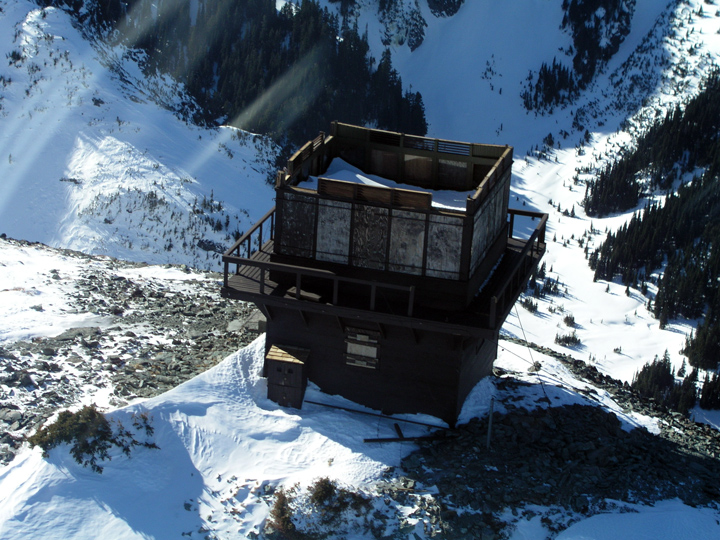 Last week, NPS rangers discovered more facility damage to a few of the fire lookouts. Here is Fremont Lookout from the air. Note that the roof is missing. Similar damage was found at Gobblers Knob (the roof blew off and a wall collasped) but Tolmie and Shriner (the other lookouts in the park) survived OK.
Last week, NPS rangers discovered more facility damage to a few of the fire lookouts. Here is Fremont Lookout from the air. Note that the roof is missing. Similar damage was found at Gobblers Knob (the roof blew off and a wall collasped) but Tolmie and Shriner (the other lookouts in the park) survived OK.
The current talk points to an April 1st road re-opening to Longmire. That would make access to the Westside Road easier and more reliable. As for Paradise, they are cautiously predicting May 1st...
 As for repairs, they just paved the road at Sunshine Point. Meanwhile, the road crew is installing more culverts at Kautz Creek. Another engineering obstacle remains at milepost 5, where the uphill lane is slumping towards the river. It may not look like much in this photo, but the embankment below is severely eroded by the Nisqually River.
As for repairs, they just paved the road at Sunshine Point. Meanwhile, the road crew is installing more culverts at Kautz Creek. Another engineering obstacle remains at milepost 5, where the uphill lane is slumping towards the river. It may not look like much in this photo, but the embankment below is severely eroded by the Nisqually River.
You may have noticed that I am now managing the photos on Flickr and have finally started posting images in the flood folder. But using blogger for this purpose isn't that easy, so we'll see how much I can do with it...
I continue to get questions about the best way to access the mountain (i.e. Paradise). For all practical purposes, getting to Paradise is almost impossible. Why? Because there is NO public access allowed along the road corridor above Longmire. That means if you have a trip to Paradise planned for later this winter or early spring, scale back your access expectations and consider other locations.
 Access to White River isn't that bad, if you have a snow machine. One party rode into the campground, parked, and then snowshoed up to the Inter Glacier. To the right, a snowboarder breaks trail through Glacier Basin (image by Don Boutry). Perhaps some climbers will follow suit? And while we're discussing access to White River and Sunrise... the current thought is that the projected road openings will go as planned next spring. This is welcome news considering the delayed openings on HWY 123; it was totally severed and may not be fully repaired and re-opened until next fall!
Access to White River isn't that bad, if you have a snow machine. One party rode into the campground, parked, and then snowshoed up to the Inter Glacier. To the right, a snowboarder breaks trail through Glacier Basin (image by Don Boutry). Perhaps some climbers will follow suit? And while we're discussing access to White River and Sunrise... the current thought is that the projected road openings will go as planned next spring. This is welcome news considering the delayed openings on HWY 123; it was totally severed and may not be fully repaired and re-opened until next fall!  Last week, NPS rangers discovered more facility damage to a few of the fire lookouts. Here is Fremont Lookout from the air. Note that the roof is missing. Similar damage was found at Gobblers Knob (the roof blew off and a wall collasped) but Tolmie and Shriner (the other lookouts in the park) survived OK.
Last week, NPS rangers discovered more facility damage to a few of the fire lookouts. Here is Fremont Lookout from the air. Note that the roof is missing. Similar damage was found at Gobblers Knob (the roof blew off and a wall collasped) but Tolmie and Shriner (the other lookouts in the park) survived OK.The current talk points to an April 1st road re-opening to Longmire. That would make access to the Westside Road easier and more reliable. As for Paradise, they are cautiously predicting May 1st...
 As for repairs, they just paved the road at Sunshine Point. Meanwhile, the road crew is installing more culverts at Kautz Creek. Another engineering obstacle remains at milepost 5, where the uphill lane is slumping towards the river. It may not look like much in this photo, but the embankment below is severely eroded by the Nisqually River.
As for repairs, they just paved the road at Sunshine Point. Meanwhile, the road crew is installing more culverts at Kautz Creek. Another engineering obstacle remains at milepost 5, where the uphill lane is slumping towards the river. It may not look like much in this photo, but the embankment below is severely eroded by the Nisqually River. You may have noticed that I am now managing the photos on Flickr and have finally started posting images in the flood folder. But using blogger for this purpose isn't that easy, so we'll see how much I can do with it...
Saturday, September 19, 2009
Mule Deer

We went to Jemez Mountains about a week ago and saw 3 mule deer. You can tell they are mule deer due to the size of their ears. This one was really close and I got a decent photo of her. I was suprised it came out this good as it was almost dark when I took it.
Friday, September 18, 2009
Black Suede Shoes: Review of Chrome Arnhems
Several months ago I was contacted by Chrome and asked to review a pair of shoes (my choice) from their new footwear line. This is the first review on Lovely Bicycle that was done upon manufacturer's request. In principle I am not against this practice, if the following criteria are met: (1) the product is something I could have bought for myself; (2) I like the company; and (3) it is understood that I will post an honest review even if my impression of the product is negative. I discussed this with the Chrome representative, and we agreed.
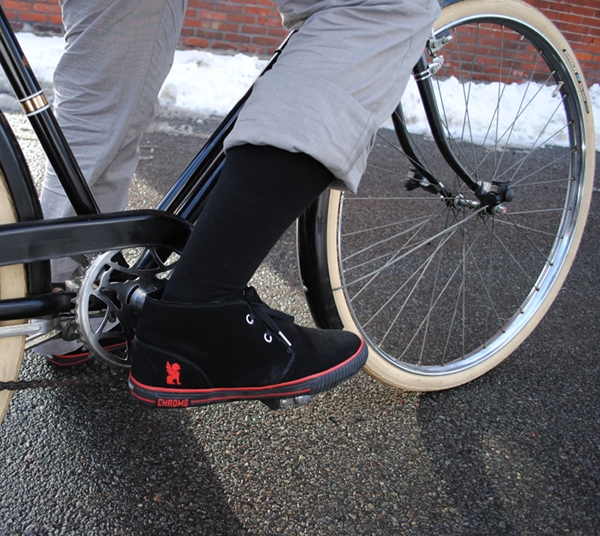 The model I chose to try were the black suede Arnhem shoes: a classic, "Chuckie-style" ankle bootie in black suede. I love suede and I love ankle boots, so the choice was a no-brainer.
The model I chose to try were the black suede Arnhem shoes: a classic, "Chuckie-style" ankle bootie in black suede. I love suede and I love ankle boots, so the choice was a no-brainer.
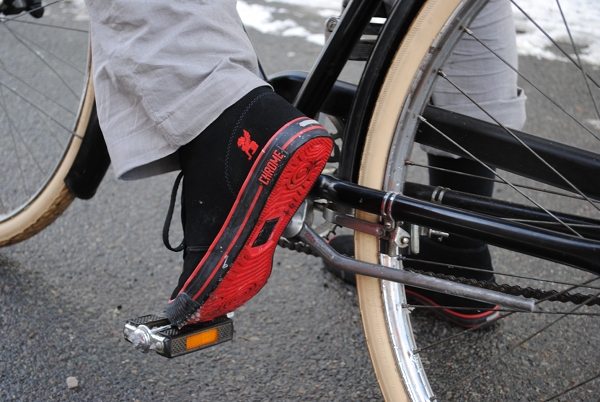 Like all the other shoes in Chrome's new footwear line (4 styles in total), the Arnhems are embellished with the red Chrome logo on the side, red piping, and screaming-red soles. The look is a bit too "bike messenger chic" for what I normally wear, but I thought that if I liked the shoes I could just sharpie over all the visible red parts (sorry, Chrome!) and they would look like classic back booties - attractive, minimalist, and (hopefully) good for long, sporty rides.
Like all the other shoes in Chrome's new footwear line (4 styles in total), the Arnhems are embellished with the red Chrome logo on the side, red piping, and screaming-red soles. The look is a bit too "bike messenger chic" for what I normally wear, but I thought that if I liked the shoes I could just sharpie over all the visible red parts (sorry, Chrome!) and they would look like classic back booties - attractive, minimalist, and (hopefully) good for long, sporty rides.
 However, my hopes were not realised and I never got to try the Chrome Arnhem shoes, because, tragically, they are not made in my size. I asked for a "size 7", naively expecting to get a women's 7. But the sizes are men's only, and so the 7 I received was the equivalent of a women's 9. There was nothing smaller. Turning tragedy into an opportunity to play "dress-up" with the Co-Habitant, I went to my local bike shop, Open Bicycle, and exchanged the size 7 for an 11, so that he could try the shoes instead.
However, my hopes were not realised and I never got to try the Chrome Arnhem shoes, because, tragically, they are not made in my size. I asked for a "size 7", naively expecting to get a women's 7. But the sizes are men's only, and so the 7 I received was the equivalent of a women's 9. There was nothing smaller. Turning tragedy into an opportunity to play "dress-up" with the Co-Habitant, I went to my local bike shop, Open Bicycle, and exchanged the size 7 for an 11, so that he could try the shoes instead.
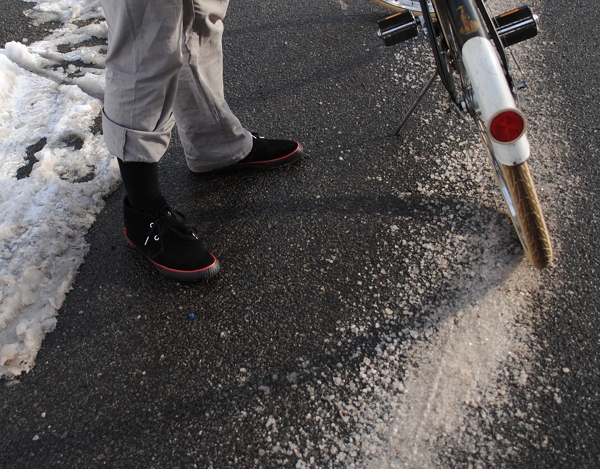 I must tell you that the Co-Habitant resisted this idea. The shoes were not his style. Plus they initially felt "weird" when I coaxed him into trying on a pair (I think they have a bit of a "reverse heel"). But he did like the soft, luxurious feel of the suede, and the craftsmanship struck him as high quality. His other shoes are all falling apart. And so, hesitantly, he decided to give the Chrome Arnhems a try - the main motivator being that they would spare him, at least temporarily, from another dreaded shopping trip.
I must tell you that the Co-Habitant resisted this idea. The shoes were not his style. Plus they initially felt "weird" when I coaxed him into trying on a pair (I think they have a bit of a "reverse heel"). But he did like the soft, luxurious feel of the suede, and the craftsmanship struck him as high quality. His other shoes are all falling apart. And so, hesitantly, he decided to give the Chrome Arnhems a try - the main motivator being that they would spare him, at least temporarily, from another dreaded shopping trip.
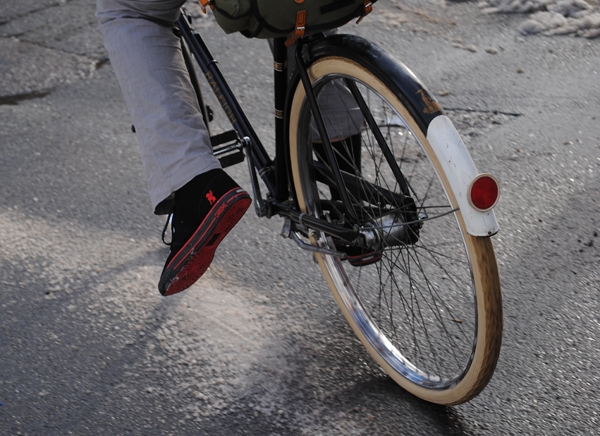 A month and a half later, he happily wears the shoes almost daily, and is making me terribly jealous with his comments about all their wonderful attributes. This is the truth, and it is quite funny that he likes them so much given that he initially refused to even put them on. Here is the break-down of his impressions:
A month and a half later, he happily wears the shoes almost daily, and is making me terribly jealous with his comments about all their wonderful attributes. This is the truth, and it is quite funny that he likes them so much given that he initially refused to even put them on. Here is the break-down of his impressions:
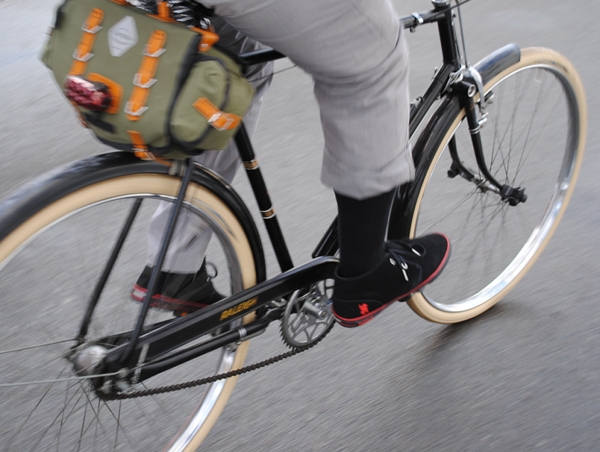 On the bike: The Co-Habitant likes to ride his bicycles fast and he does not wear toe clips. Therefore he appreciates a shoe with a stiff, grippy sole. According to him, the Chrome Arnhem shoes take the concept of "stiff grippy sole" and enhance it exponentially. In these shoes, he feels that he is able to apply significantly more power to the pedals than in any of his other shoes, which include dress shoes, casual shoes, and workboots - all of which have soles that he thought were sufficiently stiff and grippy until he tried the Chromes. In terms of grippiness, he finds the shoes to be virtually slip-less in all but the wettest weather.
On the bike: The Co-Habitant likes to ride his bicycles fast and he does not wear toe clips. Therefore he appreciates a shoe with a stiff, grippy sole. According to him, the Chrome Arnhem shoes take the concept of "stiff grippy sole" and enhance it exponentially. In these shoes, he feels that he is able to apply significantly more power to the pedals than in any of his other shoes, which include dress shoes, casual shoes, and workboots - all of which have soles that he thought were sufficiently stiff and grippy until he tried the Chromes. In terms of grippiness, he finds the shoes to be virtually slip-less in all but the wettest weather.
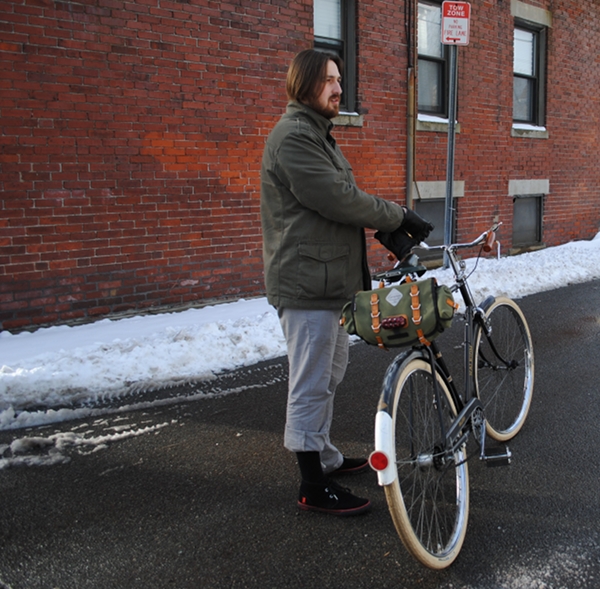 Off the bike: As far as walking goes, he says that the shoes get more comfortable over time and that, more than anything, it takes a little while to get used them. The position (angle?) in which they put his feet felt unusual to him at first, but once he got used to it, he found it comfortable. At work he sometimes has to spend 12 hour shifts mostly on his feet, and the shoes accommodate this just fine.
Off the bike: As far as walking goes, he says that the shoes get more comfortable over time and that, more than anything, it takes a little while to get used them. The position (angle?) in which they put his feet felt unusual to him at first, but once he got used to it, he found it comfortable. At work he sometimes has to spend 12 hour shifts mostly on his feet, and the shoes accommodate this just fine.
In Rain and Snow: One surprising thing about the Chrome Arnhem shoes, is that the suede is fairly water resistant, as well as roadsalt resistant. I thought for sure the shoes would get ruined if the Co-Habitant wore them in the snow and slush, but they seem to be doing fine. We did not treat the suede with anything, so this is how they came from the factory. A nice surprise, and it is good to have shoes that you can wear both during warm and cold seasons.
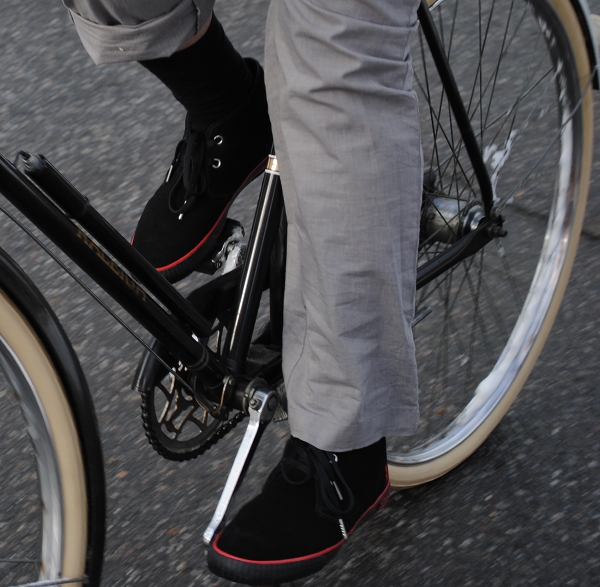 Aesthetics: The Co-Habitant likes the feel of the shoes so much, that he is willing to deal with the red soles and the logos (when his pants are rolled all the way down, only the red piping remains visible). Still, the look is not ideal. I think that Chrome should seriously consider releasing a more subdued version. This would make the shoes stylistically suitable for a greater number of cyclists. They could even be worn as dress shoes to the office - the nice suede is certainly luxurious enough. Not all of us are bike messengers or want to look like bike messengers. Just a thought!
Aesthetics: The Co-Habitant likes the feel of the shoes so much, that he is willing to deal with the red soles and the logos (when his pants are rolled all the way down, only the red piping remains visible). Still, the look is not ideal. I think that Chrome should seriously consider releasing a more subdued version. This would make the shoes stylistically suitable for a greater number of cyclists. They could even be worn as dress shoes to the office - the nice suede is certainly luxurious enough. Not all of us are bike messengers or want to look like bike messengers. Just a thought!
In conclusion, Chrome Arnhem shoes are well made, great for cycling, and can be worn in the winter. The two major complaints are the limited appeal of the current "colourway", and the lack of women's sizes. The latter is pretty upsetting, given how much the Co-Habitant likes his shoes. If Chrome ever releases the Arnhems in a size to fit my women's size 7 feet, I will gladly buy a pair... And yes, I will take a sharpie to it!
 The model I chose to try were the black suede Arnhem shoes: a classic, "Chuckie-style" ankle bootie in black suede. I love suede and I love ankle boots, so the choice was a no-brainer.
The model I chose to try were the black suede Arnhem shoes: a classic, "Chuckie-style" ankle bootie in black suede. I love suede and I love ankle boots, so the choice was a no-brainer. Like all the other shoes in Chrome's new footwear line (4 styles in total), the Arnhems are embellished with the red Chrome logo on the side, red piping, and screaming-red soles. The look is a bit too "bike messenger chic" for what I normally wear, but I thought that if I liked the shoes I could just sharpie over all the visible red parts (sorry, Chrome!) and they would look like classic back booties - attractive, minimalist, and (hopefully) good for long, sporty rides.
Like all the other shoes in Chrome's new footwear line (4 styles in total), the Arnhems are embellished with the red Chrome logo on the side, red piping, and screaming-red soles. The look is a bit too "bike messenger chic" for what I normally wear, but I thought that if I liked the shoes I could just sharpie over all the visible red parts (sorry, Chrome!) and they would look like classic back booties - attractive, minimalist, and (hopefully) good for long, sporty rides. However, my hopes were not realised and I never got to try the Chrome Arnhem shoes, because, tragically, they are not made in my size. I asked for a "size 7", naively expecting to get a women's 7. But the sizes are men's only, and so the 7 I received was the equivalent of a women's 9. There was nothing smaller. Turning tragedy into an opportunity to play "dress-up" with the Co-Habitant, I went to my local bike shop, Open Bicycle, and exchanged the size 7 for an 11, so that he could try the shoes instead.
However, my hopes were not realised and I never got to try the Chrome Arnhem shoes, because, tragically, they are not made in my size. I asked for a "size 7", naively expecting to get a women's 7. But the sizes are men's only, and so the 7 I received was the equivalent of a women's 9. There was nothing smaller. Turning tragedy into an opportunity to play "dress-up" with the Co-Habitant, I went to my local bike shop, Open Bicycle, and exchanged the size 7 for an 11, so that he could try the shoes instead. I must tell you that the Co-Habitant resisted this idea. The shoes were not his style. Plus they initially felt "weird" when I coaxed him into trying on a pair (I think they have a bit of a "reverse heel"). But he did like the soft, luxurious feel of the suede, and the craftsmanship struck him as high quality. His other shoes are all falling apart. And so, hesitantly, he decided to give the Chrome Arnhems a try - the main motivator being that they would spare him, at least temporarily, from another dreaded shopping trip.
I must tell you that the Co-Habitant resisted this idea. The shoes were not his style. Plus they initially felt "weird" when I coaxed him into trying on a pair (I think they have a bit of a "reverse heel"). But he did like the soft, luxurious feel of the suede, and the craftsmanship struck him as high quality. His other shoes are all falling apart. And so, hesitantly, he decided to give the Chrome Arnhems a try - the main motivator being that they would spare him, at least temporarily, from another dreaded shopping trip. A month and a half later, he happily wears the shoes almost daily, and is making me terribly jealous with his comments about all their wonderful attributes. This is the truth, and it is quite funny that he likes them so much given that he initially refused to even put them on. Here is the break-down of his impressions:
A month and a half later, he happily wears the shoes almost daily, and is making me terribly jealous with his comments about all their wonderful attributes. This is the truth, and it is quite funny that he likes them so much given that he initially refused to even put them on. Here is the break-down of his impressions: On the bike: The Co-Habitant likes to ride his bicycles fast and he does not wear toe clips. Therefore he appreciates a shoe with a stiff, grippy sole. According to him, the Chrome Arnhem shoes take the concept of "stiff grippy sole" and enhance it exponentially. In these shoes, he feels that he is able to apply significantly more power to the pedals than in any of his other shoes, which include dress shoes, casual shoes, and workboots - all of which have soles that he thought were sufficiently stiff and grippy until he tried the Chromes. In terms of grippiness, he finds the shoes to be virtually slip-less in all but the wettest weather.
On the bike: The Co-Habitant likes to ride his bicycles fast and he does not wear toe clips. Therefore he appreciates a shoe with a stiff, grippy sole. According to him, the Chrome Arnhem shoes take the concept of "stiff grippy sole" and enhance it exponentially. In these shoes, he feels that he is able to apply significantly more power to the pedals than in any of his other shoes, which include dress shoes, casual shoes, and workboots - all of which have soles that he thought were sufficiently stiff and grippy until he tried the Chromes. In terms of grippiness, he finds the shoes to be virtually slip-less in all but the wettest weather. Off the bike: As far as walking goes, he says that the shoes get more comfortable over time and that, more than anything, it takes a little while to get used them. The position (angle?) in which they put his feet felt unusual to him at first, but once he got used to it, he found it comfortable. At work he sometimes has to spend 12 hour shifts mostly on his feet, and the shoes accommodate this just fine.
Off the bike: As far as walking goes, he says that the shoes get more comfortable over time and that, more than anything, it takes a little while to get used them. The position (angle?) in which they put his feet felt unusual to him at first, but once he got used to it, he found it comfortable. At work he sometimes has to spend 12 hour shifts mostly on his feet, and the shoes accommodate this just fine.In Rain and Snow: One surprising thing about the Chrome Arnhem shoes, is that the suede is fairly water resistant, as well as roadsalt resistant. I thought for sure the shoes would get ruined if the Co-Habitant wore them in the snow and slush, but they seem to be doing fine. We did not treat the suede with anything, so this is how they came from the factory. A nice surprise, and it is good to have shoes that you can wear both during warm and cold seasons.
 Aesthetics: The Co-Habitant likes the feel of the shoes so much, that he is willing to deal with the red soles and the logos (when his pants are rolled all the way down, only the red piping remains visible). Still, the look is not ideal. I think that Chrome should seriously consider releasing a more subdued version. This would make the shoes stylistically suitable for a greater number of cyclists. They could even be worn as dress shoes to the office - the nice suede is certainly luxurious enough. Not all of us are bike messengers or want to look like bike messengers. Just a thought!
Aesthetics: The Co-Habitant likes the feel of the shoes so much, that he is willing to deal with the red soles and the logos (when his pants are rolled all the way down, only the red piping remains visible). Still, the look is not ideal. I think that Chrome should seriously consider releasing a more subdued version. This would make the shoes stylistically suitable for a greater number of cyclists. They could even be worn as dress shoes to the office - the nice suede is certainly luxurious enough. Not all of us are bike messengers or want to look like bike messengers. Just a thought!In conclusion, Chrome Arnhem shoes are well made, great for cycling, and can be worn in the winter. The two major complaints are the limited appeal of the current "colourway", and the lack of women's sizes. The latter is pretty upsetting, given how much the Co-Habitant likes his shoes. If Chrome ever releases the Arnhems in a size to fit my women's size 7 feet, I will gladly buy a pair... And yes, I will take a sharpie to it!
Subscribe to:
Posts (Atom)


